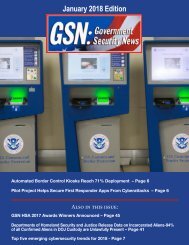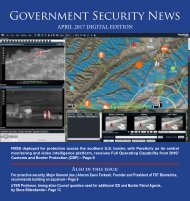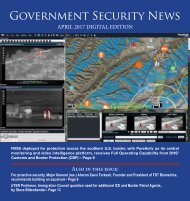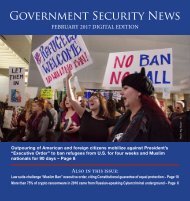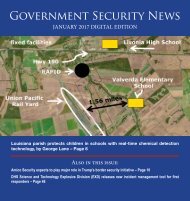GSN_Nov-Dec_FINAL_Yumpu
Create successful ePaper yourself
Turn your PDF publications into a flip-book with our unique Google optimized e-Paper software.
agencies and municipalities have<br />
asked their citizens for two key<br />
pieces of contact information: their<br />
cell phone number and their social<br />
media information. The cell phone<br />
is nearly ubiquitous among people<br />
today and it’s the only device that<br />
people carry and actively engage<br />
with throughout the day. However,<br />
it’s important to realize that no contact<br />
path, including a cellular device,<br />
is 100% reliable, 100% of the time<br />
(which is critical in an emergency<br />
situation when the message must<br />
reach as many people as possible).<br />
This is an important tenet that the<br />
FCC should consider as part of the<br />
EAS overhaul.<br />
A robust, multi-modal mass communications<br />
program enables government<br />
officials to more accurately<br />
and effectively fuel the spread of<br />
information during an emergency.<br />
Once the communication channels<br />
have been decided upon, consider<br />
supporting the program through<br />
advertising, public relations, social<br />
media and even traditional physical<br />
media to get the word out about<br />
how people can sign up for the program.<br />
The FCC should even follow<br />
the lead of local communities,<br />
such as Lewisville, Texas, where a<br />
local emergency management department<br />
conducted an extensive<br />
awareness program, which included<br />
development of marketing materials<br />
and a Public Service Announcement<br />
(PSA). The awareness program was<br />
well received and encouraged residents<br />
to enroll their other devices<br />
and contact paths. The community<br />
saw a 262% increase in resident optins<br />
in less than a year.<br />
The Power of Rich,<br />
Multimedia Messages<br />
Pictures, graphics and sound clips<br />
have permeated our everyday communications<br />
alongside plain text,<br />
and are a valuable tool in crisis communications.<br />
Just think for a moment<br />
back to the New Jersey bombing<br />
incident. If the FCC were able to<br />
issue a picture of the suspect during<br />
their communication, local citizens<br />
would be empowered to become<br />
helpful informants to locating the<br />
suspect. People in crisis situations<br />
tend to be hyper-focused on any and<br />
all stimulus so asking them to take<br />
27<br />
the extra step to locate an image of<br />
the suspect via a Google search is a<br />
bridge too far for many to cross. The<br />
ability to provide people with a succinct<br />
synopsis – complete with the<br />
who’s, where’s, why’s and how’s – is<br />
critical to stomping out uncertainty<br />
and panic from the get-go. A picture<br />
is worth a thousand words and can<br />
serve as a critical piece of information<br />
in criminal investigations for<br />
police officers.<br />
Real-Time Guidance During a Crisis<br />
Crisis situations are fluid and dynamic.<br />
To properly manage an emergency<br />
event, specific people need to<br />
take decisive actions throughout a<br />
prolonged period of time. This requires<br />
an immense amount of realtime<br />
coordination that is impossible<br />
unless an agency or municipality is<br />
able to communicate with targeted<br />
groups during an incident. EAS<br />
should incorporate the fundamentals<br />
of two-way communication,<br />
and targeted notification capabilities,<br />
where possible.<br />
As an example, let’s imagine an<br />
active shooter situation within a<br />
government building. Government<br />
officials could quickly communicate<br />
with security personnel to<br />
confront the gunman while directing<br />
other workers, including those<br />
More on page 51




